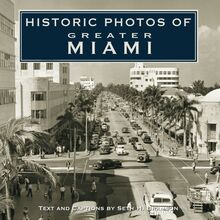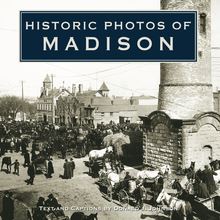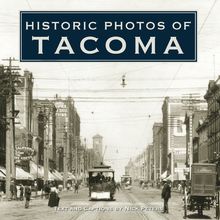Historic Photos of Oklahoma , livre ebook
129
pages
English
Ebooks
2009
Vous pourrez modifier la taille du texte de cet ouvrage
Obtenez un accès à la bibliothèque pour le consulter en ligne En savoir plus
Découvre YouScribe en t'inscrivant gratuitement
Découvre YouScribe en t'inscrivant gratuitement
129
pages
English
Ebooks
2009
Vous pourrez modifier la taille du texte de cet ouvrage
Obtenez un accès à la bibliothèque pour le consulter en ligne En savoir plus
Publié par
Date de parution
01 janvier 2009
Nombre de lectures
1
EAN13
9781618584175
Langue
English
Poids de l'ouvrage
15 Mo
Oklahoma has an excellent photographic record, largely because the twin territories developed along the same general timeline as modern photography itself. Historic Photos of Oklahoma is not an illustrated history of Oklahoma, nor is it an attempt at a visual chronology of the state. Rather, the photographs included here tell the story of this diverse group of people called Oklahomans as witnessed in their faces, the homes they cherished, and the streets they traveled.
Just as viewing a succession of school photos reveals the periods of beauty and awkwardness, innocence and maturity, and hardship and joy in a child’s life, the reader of this book will see the tragedy of Indian removal, the exuberance of land runs, the shame of segregation, the anguish of the Depression, and the optimism for the future in Oklahoma. In between are glimpses of how we used to live, work, and play in the forty-sixth state of the Union.
Publié par
Date de parution
01 janvier 2009
Nombre de lectures
1
EAN13
9781618584175
Langue
English
Poids de l'ouvrage
15 Mo
HISTORIC PHOTOS OF
OKLAHOMA
T EXT AND C APTIONS BY L ARRY J OHNSON
On July 4, 1889, all of Guthrie lined up to celebrate the nation s 113th birthday and to show the town s appreciation for a special visitor: Representative Bishop Walden Perkins. The Kansas congressman was called by some the Father of Oklahoma because of his successful attachment of the Oklahoma clause, which called for opening portions of Indian Territory to white settlement, to the Indian Appropriations bill.
HISTORIC PHOTOS OF
OKLAHOMA
Turner Publishing Company
200 4th Avenue North Suite 950
Nashville, Tennessee 37219
(615) 255-2665
www.turnerpublishing.com
Historic Photos of Oklahoma
Copyright 2009 Turner Publishing Company
All rights reserved.
This book or any part thereof may not be reproduced or transmitted in any form or by any means, electronic or mechanical, including photocopying, recording, or by any information storage and retrieval system, without permission in writing from the publisher.
Library of Congress Control Number: 2008908518
ISBN-13: 978-1-59652-513-9
Printed in China
09 10 11 12 13 14 15-0 9 8 7 6 5 4 3 2 1
C ONTENTS
A CKNOWLEDGMENTS
P REFACE
W AY D OWN Y ONDER IN THE I NDIAN N ATION (1870 S -1900)
T ERRITORY F OLKS S HOULD S TICK T OGETHER (1901-1929)
A C URTAIN OF B LACK R OLLED D OWN (1930-1945)
I VE N EVER B EEN TO H EAVEN , B UT I VE B EEN TO O KLAHOMA (1946-1968)
N OTES ON THE P HOTOGRAPHS
In September 1889, not long after the visit by Representative Perkins, Guthrie received a congressional delegation that had traveled west to inspect the conditions in Oklahoma. Here, Iowa Indians pose in front of Nowlan s Restaurant. They had come from their nearby reservation seeking the approval of the congressmen to unite with the Otoe tribe.
A CKNOWLEDGMENTS
With the exception of cropping images where needed and touching up imperfections that have accrued over time, no other changes have been made to the photographs in this volume. The caliber and clarity of many photographs are limited to the technology of the day and the ability of the photographer at the time they were made.
This volume, Historic Photos of Oklahoma , is the result of the cooperation and efforts of many individuals, organizations, and corporations. It is with great thanks that we acknowledge the valuable contribution of the following for their generous support:
Library of Congress
Oklahoma Historical Society
The author would like to thank Pamela and Margaret Nell for their valuable assistance in selecting photographs for this volume.
Madeleine Claire, Victoria, and Jandy provided wonderful suggestions and support in the writing of the text.
P REFACE
In many families, the first few years of the first-born child are fully documented on film. From the first day, the photo albums begin to pile up; but as years go by, the albums get thinner, and before long the annual school photo is the only reliable photographic record of the person s childhood. So it has been with several Oklahoma towns and cities. Because of their instant birth, the first days of many Oklahoma towns are remarkably well recorded; but from later years, mostly what remain are staid real-estate photographs and views of commercial districts. As one moves into the 1950s and 1960s, the photographs available from archives begin to dwindle, dissipating further in the 1970s.
Still, Oklahoma has an excellent photographic record of life in what was then Indian Territory, before the arrival of the town builders. Photography in the late nineteenth century had become portable, affordable, and popular. By that time, the Five Civilized Tribes (Cherokee, Chickasaw, Choctaw, Muscogee [Creek], and Seminole) had been in eastern and southern Indian Territory for over 50 years. Photographs of that part of the state in that era depict the numerous missionary boarding schools in the region as well as the large homes built by the more fortunate members and leaders of the tribes.
In the west, the scene was quite different. There, images of the movable dwellings of nomadic plains tribes are contrasted against the primitive dwellings of white settlers. Photographers like Will Soule and Edward Curtis were moved by the belief that Indian Territory represented the last opportunity to capture indigenous cultures in their natural states. Although these men may not have been thoroughly knowledgeable about the cultures, they were generally earnest in their respect for the tribes, and a great debt is owed them for preserving images of these people and their lives. Likewise, lensmen such as William S. Prettyman and Andrew Forbes are remembered for their work with some of the last real working cowboys and drovers as they worked the ranchlands of the west and the panhandle.
Historic Photos of Oklahoma is not an illustrated history of Oklahoma, nor is it an attempt at a visual chronology of the state. Readers seeking photographs of famous people and landmark buildings (though there are a few) may be disappointed. Rather, the selection of photographs here tells the story of this diverse group of people called Oklahomans as witnessed in their faces, the homes they cherished, and the streets they lived in.
Just as viewing a succession of those school photos reveals the periods of beauty and awkwardness, innocence and maturity, hardship and joy in a child s life, the reader of this book will see the tragedy of Indian removal, the exuberance of land runs, the shame of segregation, the anguish of the Depression, and the optimism for the future. In between are glimpses of how we used to live, work, and play in the forty-sixth state of the Union.
-Larry Johnson
The Finley Bowen family stands outside their homestead northeast of Coyle. This photo was likely taken in the aftermath of a tornado outbreak across Kingfisher and Logan counties on May 2, 1892. Damage looks slight here, but three died in Kingfisher and several buildings were destroyed.
W AY D OWN Y ONDER IN THE I NDIAN N ATION
(1870 S -1900)
The Indian Removal Act of 1830 and the subsequent tragedy of the Trail of Tears migration define the state s early history, as the Five Civilized Tribes and, later, smaller tribes from around the United States were forced to remake their lives in Indian Territory. The five nations largely clung to the hills and timber of the south and east, preferring to lease the expansive land beyond the Cross Timbers to ranchers. Some built large plantations, while others tried to maintain traditional lives; all jealously guarded their autonomy until the Civil War forced them to make difficult choices.
Following the Civil War, during which some factions of the tribes joined the Confederacy, much of the western lands of Indian Territory were punitively stripped away and used to facilitate the removal of several plains tribes, including the Cheyenne, Arapaho, Comanche, and Kiowa. The United States Army s Fort Sill (1869) and Fort Reno (1875) represented the first permanent white settlements in the west, though ranchers from Texas and Kansas had already begun leasing and squatting on lands in the Cherokee Outlet and No-Man s Land of the panhandle.
Meanwhile, in the east, the five nations fought unsuccessfully to prevent the Missouri-Kansas-Texas Railroad (commonly known as the Katy Railroad) from piercing their homeland in order to build a route from the cattle country of Texas to markets in Kansas City. They feared, rightly, that the railroad would soon bring white settlers and the end of their autonomy. Intermarriage and the presence of outlaws and other undesirables had already caused tensions in the region.
Throughout the 1870s and 1880s, white farmers pressured the federal government to open up land in Indian Territory to white settlement. These boomers were finally successful, and in 1889 the Unassigned Lands-land in the center of the territory that had not been assigned to a particular tribe-were opened to white settlers. Within a year the western half of Indian Territory was organized into Oklahoma Territory; a series of runs and lotteries brought thousands of settlers, and hundreds of towns sprang up overnight.
The early photographs of Oklahoma reveal the abundant cultural and ecological diversity of the state as well as the many strange dualities that have been present on its land since the Louisiana Purchase: the treeless flatlands of the west and the hilly forests of the east; the plains Indians and the southeastern Indians; the outlaws and the missionaries.
After the battle of Claremore Mound between the Osage and newly arrived Cherokee in 1817, the Army established a presence in the Three Forks area to keep the peace. The building seen here was erected in 1818 (though photographed much later) and housed officers until Fort Gibson was built nearby in 1824.
This sturdy cabin was the home of Basil LeFlore, a future Choctaw governor, in 1837. Most of the prominent LeFlore family was able to remain in Mississippi, but Basil went west during the removal and became an important political figure in the 1850s.
The Presbyterian missionary Alfred Wright had worked among the Choctaw in Mississippi beginning in the 1820s and resumed his work in Indian Territory after the removal. In 1846, parishioners from his Wheelock mission near Idabel built this stone church-it stands today as the oldest church in Oklahoma.
The Choctaw Nation embraced formal education, working with and even funding missionary schools. The Armstrong Academy was a boarding school for boys established near Bokchito in 1844; this structure, though photographed much later, was built only a few years after the school was founded.
Fort Sill was established in southwestern Oklahoma in 1869 to pacify the southern plains tribes. Two miles away, the Quakers operated the Kiowa-Comanche Agency, where they constructed this school from native stone in 1871.
This group of Comanches encamped near Fort Sill in 1873 was like














